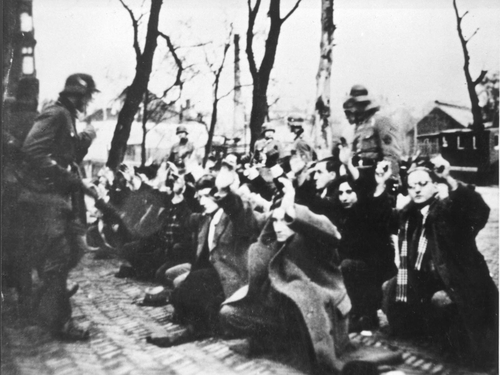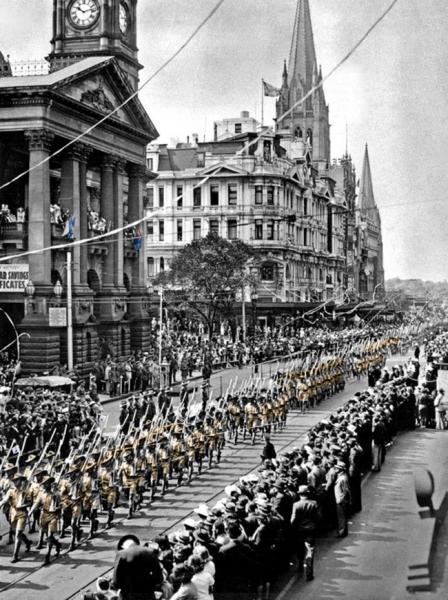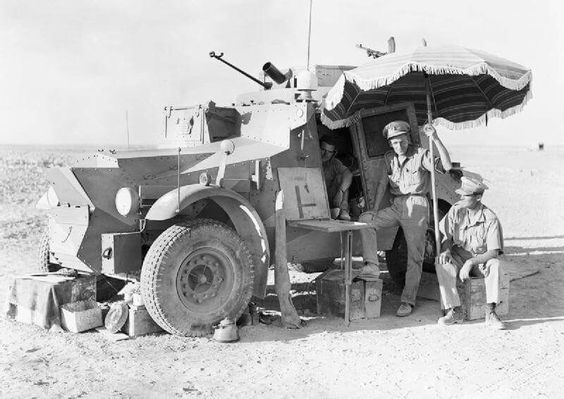Wednesday 21 May 1941
 |
| Battleship Bismarck in the Norwegian fjord of Grimstadfjord, 21 May 1941 (photo taken from Prinz Eugen). |
These 34,000 British troops will fact 35,000 French troops under the command of General Dentz. The main French force is the 6th French Foreign Legion Regiment, which has 3000 soldiers of mixed nationalities including Germans, French, Russians, Spanish and Irish.
The Vichy air force numbers 100 planes and the RAF about 70. While the RAF has many capable Hawker Hurricanes and Curtiss P-40 Tomahawks, the French Dewoitine S520 surprises many with its capabilities. At sea, there is no contest, as the French only have a few destroyers while the Royal Navy can call upon the entire Mediterranean Fleet with aircraft carriers, battleships, cruisers and numerous other classes of ships.
The British have ray of hope when a defecting Vichy French soldier, Colonel Collet, reports that morale in Syria is poor. He claims that the Vichy troops, already ordered to defensive positions along the southern Syrian border, will not resist an invasion.
Fighting continues in Fallujah, where the Iraqis make a stand against the advancing British troops of Kingcol.
 |
| Battleship Bismarck as seen from cruiser Prinz Eugen in the Norwegian fjord of Grimstadfjord, 21 May 1941. |
RAF Fighter Command conducts a Circus operation against the Gosnay Power Station. Bomber Command also sends 45 bombers on various anti-shipping operations.
East African Campaign: The East African 22nd Infantry Brigade captures Colito in Galla-Sidamo.
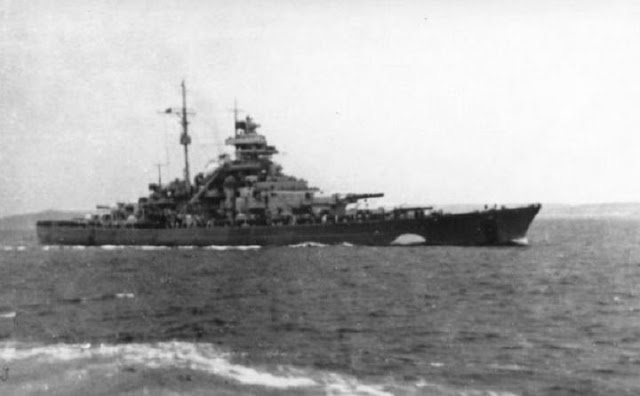 |
| Battleship Bismarck on her way up the Norwegian coast after her crew has removed her Baltic camouflage but left her false bow wave. |
U-93 (Kptlt. Claus Korth), part of Wolfpack West south of Greenland, launches an attack on Convoy HX-126, which already has lost seven ships on the 20th. At 05:29, Korth torpedoes and badly damages 6235-ton Dutch tanker Elusa. The Elusa is carrying gasoline and catches fire, and the crew abandons ship. The ship remains afloat until the 22nd, but is a flaming wreck, so the ship is left to its fate (it ultimately sinks). There are 49 survivors, taken aboard quickly by a convoy escort destroyer.
U-98 (Kptlt. Robert Gysae), also part of Wolfpack West southeast of Cape Farewell, sank the Rothermere on the 20th, and today it sinks 7402-ton British freighter Marconi. There are 22 deaths and 56 survivors who are picked up by US Coast Guard Cutter General Greene. This sinking by U-98 is unconfirmed, but the Marconi definitely sinks on the 21st.
Royal Navy 16.5-ton armed yacht HMY Hanyards is lost due to unknown reasons, perhaps a mine.
 |
| Battleship Bismarck enters Grimstadfjord near Bergen, 21 May 1941 (picture taken from cruiser Prinz Eugen). |
The Admiralty details two capital ships, battlecruiser HMS Hood and unfinished battleship Prince of Wales, to sail from Scapa Flow, Scotland to reinforce the standing patrol in the Denmark Strait on two hour's notice. Prince of Wales still has engineers working on its faulty guns. The many reconnaissance photos and missions by the British are the start of their "German battleship obsession" that the Germans will put to good use in the coming years with their handling of the Tirpitz.
Convoy OB 325 departs from Liverpool.
Canadian minesweeper HMCS Drummondville is launched in Montreal.
U-129 (Kapitänleutnant Nicolai Clausen) and U-402 (Kapitänleutnant Freiherr S. von Forstner) are commissioned, U-156 and U-208 are launched, and U-170 is laid down.
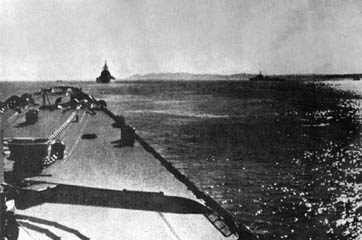 |
| Bismarck as seen from Prinz Eugen, 21 May 1941. |
In the King George Hotel in Athens, the commanding general of the XI. Fliegerkorps, Major General Kurt Student, has a difficult strategic decision to make. On it, the fate of his fledgling Fallschirmjäger creation rests, along with the fate of Wehrmacht interests in the Mediterranean. If he fails, the heretofore unstoppable success of German troops will be ended in truly humiliating fashion, and his entire command virtually wiped out.
With few and fragmentary reports coming from the island, General Student has little to go on. However, he knows that he has to act fast because the airborne troops already are running out of ammunition. However, a reconnaissance flight over Maleme airfield reports no antiaircraft fire, and during a desperate supply flight of Junkers Ju 52s, one carrying boxes of needed ammunition manages to put down under fire on the nearby beach and come to a stop just short of some rocks. General Student makes his decision: send reinforcements of the 5th Mountain Division to land at Maleme and forget about the other landing sites on the island.
 |
| Fallschirmjäger arriving at Maleme airport, 21 May 1941. |
The German planes continue landing throughout the evening and night, with new arrivals crashing into planes already there, creating a mass of wrecked and intermingled planes. Gradually and painfully, the Fallschirmjäger consolidate their hold on the airfield. At 16:00, Luftwaffe Colonel Bernhard Hermann Ramcke, accompanied by 500 reinforcements, drops in by parachute east of the airfield to take command.
As the day ends, the Germans have a tenuous hold on Maleme airfield. British commander General Bernard Freyberg finally realizes that the Germans' attack spearhead - schwerpunkt - is Maleme. He orders a counterattack by the New Zealand 20th Battalion, but it needs to hand off its own position to attack, so the 2/7th Battalion - which has no transport - is ordered to march 18 miles (29 km) north. The counterattack must wait for them arrive at 23:30, and then the 20th Battalion prepares to counterattack as soon as it can get into position on the 22nd.
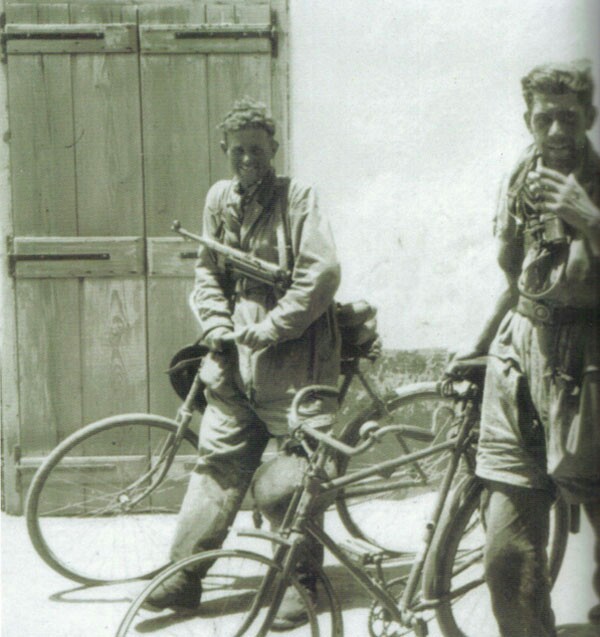 |
| Fallschirmjäger on Crete, 21 May 1941. |
Only heroic action by the captain of the Lupo, who stops to pick up swimming Germans in the night, saves hundreds of men. Lupo is badly damaged but makes it back to port with survivors. Another Italian torpedo boat, Lira, also picks up survivors. One caique from the supply convoy reaches Maleme at Cape Spatha, not nearly enough to be decisive, while a cutter struggles into the harbor at Akrotiri and takes heavy fire from a British patrol and provides no help at all.
Another German convey departs Piraeus, escorted by Italian torpedo boat Sagittario. It also ultimately turns back. In the confusion of ships around Piraeus, a Luftwaffe bomber damages Italian destroyer Sela.
In the morning, the Luftwaffe locates cruiser HMS Ajax and destroyer Juno withdrawing to the southwest of Crete. The German planes sink the Juno, leaving 97 survivors, 28 dead and 21 wounded. Ajax is only slightly damaged by a near miss and remains on patrol with no casualties.
A large force of Royal Navy destroyers departs Malta at twilight for operations north of Crete. These are HMS Jackal, Kashmire, Kelly, and Kelvin.
 |
| The NY Times announces the invasion of Crete, 21 May 1941. |
Italian 248 ton freighter Gladiator hits a mine and sinks off Sebenico.
Italian naval trawler Pellegrino Matteucci hits a mine and sinks northwest of Lefkos.
Italian destroyer Carlo Mirabello hits a mine and sinks in the Ionian Sea off Cephalonia. German freighters Kybfels and Marburg also sink from mines in the same area. The loss of the Marburg is particularly damaging, as it carries 60 tanks and 683 men of Panzer Division 2.
In London, Winston Churchill professes to be optimistic about Crete. The War Cabinet Defence Committee minutes show that he:
saw no reason why we should not retain our hold on the Island provided that General Wavell was able to land reinforcements on the southern side and that the Navy could prevent anything in the way of a German seaborne landing.In this, Churchill appears to be subtly planting the idea of Middle East Commander Wavell as a future scapegoat. There are no plans to land anyone on the rough southern coast of Crete, and there is plenty of British manpower - but also lots of muddle and poorly equipped soldiers.
In a cable to Wavell, Churchill is a bit more honest about the true state of affairs on Crete. He notes that General Freyberg "declares he is hard-pressed." He adds somewhat gratuitously, "Presume you are already reinforcing him to the utmost to master enemy airborne attack," when in fact there is no way for Wavell to "reinforce" Freyberg. If the airfields on Crete and surrounding seas cannot be held, sending more troops to buttress the large numbers already there would be merely sacrificial.
Over the Libyan Front, planes from the 3rd Staffel of I./JG 27 shoots down five RAF Blenheims.
Royal Navy aircraft carriers, during Operation Splice, launch 48 Hawker Hurricanes and four Fulmars (as guide planes) to Malta. All but two Hurricanes reach the island, and the carriers and accompanying ships return to Gibraltar. Seventeen of the Hurricanes refuel and fly on immediately to Cairo. In addition to these planes, Some Bristol Blenheim Mk IV bombers of RAF No. 82 Squadron also fly into Malta directly from Cornwall, England (one lost at sea).
While the planes are arriving on Malta from Operation Splice, a major Luftwaffe attack occurs. They raid Luqa airfield, destroying two Wellingtons and damaging one Blenheim, one Hurricane, and one Beaufighter.
Royal Navy cruiser minelayer HMS Abdiel lays mines off the west coast of Greece.
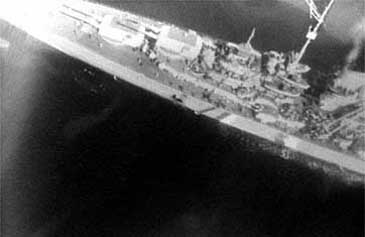 |
| Reconnaissance photo of battleship Bismarck, taken by an RAF plane as she approaches Norway on 21 May 1941. |
US/German Relations: U-69 (Kptlt. Jost Metzler), on its third patrol and operating about 750 miles west of Freetown, Sierra Leone, spots 4999 ton US freighter Robin Moore traveling independently. The Robin Moore flies the flag of a neutral country, and normal U-boat practice is to leave US vessels alone. However, Robin Moore is carrying cargo from New York City to Mozambique via South Africa which includes items that can be interpreted as military cargo, including shotgun shells and .22 caliber rifles. The bulk of its crew is 450 autos and trucks - which also can be characterized as war equipment under some interpretations.
Metzler stops the Robin Moore and orders the passengers and crew to disembark, so they take to lifeboats. Someone on the U-boat tells the mate of the Robin Moore that Metzler simply decided to "let us have it." U-69 then sinks the Robin Moore using a torpedo and the deck gun. Metzler then gives the survivors some tins of black bread and butter, states that the ship was sunk for carrying war contraband and leaves the scene and the 37 survivors are left adrift, but all eventually are saved by two different freighters. Their survival somewhat mitigates the impact on public opinion.
According to a later investigation, it will be determined that Duquesne Spy Ring member Leo Waalen had sent a radio signal to Germany with the ship's expected sailing date. Thus, the interception of the Robin Moore by U-69 may not have been accidental, though Adolf Hitler is on record as opposing any action that could bring the United States into the war. It must be noted that the Royal Navy routinely stops and confiscates neutral ships found to be in the service of the Reich, so this is not in violation of international law. However, this will become a major international incident once news of the sinking reaches Washington, D.C.
Separately, but perhaps related in a larger sense, the German occupation authorities tell US diplomats to leave the country. They are given until 10 June to return to the United States.
 |
| "The BISMARCK in Grimstadfjord" Evening of 21 May 1941. © IWM (CS 159) |
Whatever happens, you may be sure that we shall fight on, and I am sure we can at least save ourselves. But what is the good of that?The somewhat brief (for Churchill) message is one of the most downbeat that Churchill sends throughout the war.
President Roosevelt allocates six small aircraft carriers to the Royal Navy pursuant to Lend Lease. However, these are not ready yet and will be delivered over the course of the year. The ships will become British Aircraft Escort Vessels or BAVGs.
Soviet Government: At a Central Committee War Section meeting in the Kremlin, Joseph Stalin dismisses spy reports from Richard Sorge that a German attack is imminent. Air force General Proskurov, head of Soviet military intelligence, tells Stalin he is wrong and that the Germans are about to attack. Proskurov is immediately arrested and replaced by General Filipp I. Golikov. Proskurov will be shot in October 1941.
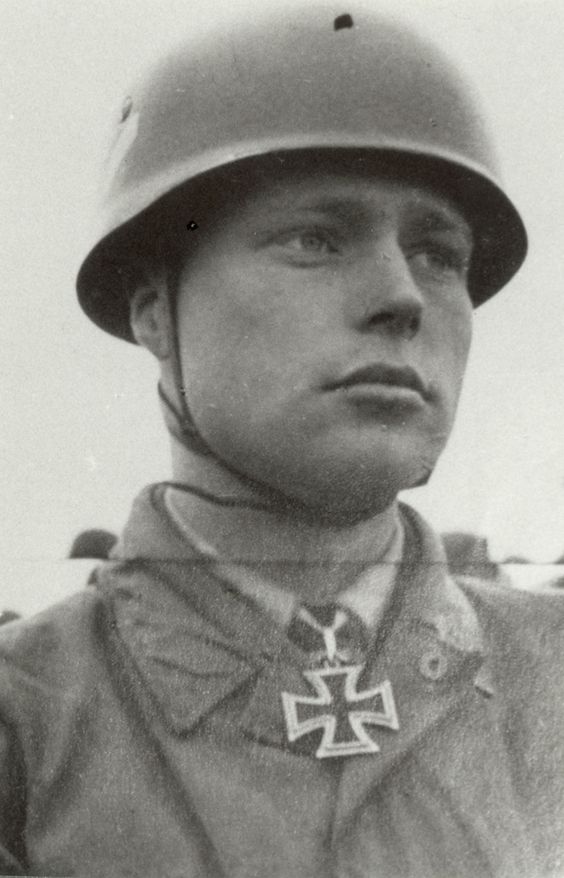 |
| Wolfgang Graf von Blücher (31 January 1917 – 21 May 1941), one of three brothers killed within hours during the Battle of Crete, |
Yes, and another report said that those who landed at Retimo were wearing English battle-dress. I see that the Germans have denied this.History shows that the German paratroopers were wearing proper German uniforms.
At most, Wehrmacht Fallschirmjäger uniforms bear only a slight resemblance to Allied uniforms. Any claim that the Germans are violating the rules of war is false, and it is unclear why Churchill makes a contrary claim at this time. Any soldier wearing an opponent's uniform is considered a spy by well-established international law and is subject to immediate execution. Churchill speaks darkly of allowing "discretion to those on the spot."
German Government: Adolf Hitler spends a day alone at his old apartment in Munich.
 |
| US freighter Robin Moore, taken shortly before its sinking on 21 May 1941. |
Your promotion to the highest military rank will be warmly welcomed, not only for your great and devoted services, but as a leader of a people whose fighting men have been playing a most brilliant part in the victorious campaign in East Africa.South African troops and aircraft have been playing a key role in the conquest of East Africa.
Philippines: US Secretary of War Henry L. Stimson receives a call from a Manila telephone official, Joseph Stevenot, that Philippines defenses need to be improved. He proposes that General Douglas MacArthur be recalled to duty. MacArthur is a field marshal in the Philippine Army since 24 August 1936, but has retired from the US Army, but remains an informal advisor to Philippines President Manuel Quezon. He is considered the top US expert on Asian affairs. Stimson decides to pass the suggestion along to Chief of Staff George Marshall, but notes in his diary that Marshall already has decided to restore General MacArthur to the command of the Philippines Department should there be an emergency. Whether or not MacArthur had something to do with Stevenot's phone call is unclear.
US Major General George Grunert, commander of the Philippine Department, independently requests that a conference be held with a view of improving Philippine defenses. He proposes that this be accomplished with $52 million derived from sugar excise taxes and currency devaluations.
China: Chinese Polikarpov I-153 fighters shoot down one Japanese Mitsubishi bomber and damage another over Lanzhou, Gansu Province. The bombers are based in Taiwan. This is the first victory by the Chinese Polikarpov fighters over Japanese planes.
Holocaust: The Natzweiler-Struthof concentration camp opens near Strasbourg, France. It is the only German-run camp on (future) French territory.
French Homefront: Military tribunals continue for those suspected of disloyalty. Today, a court sentences 56 enlisted men to death or hard labor for supporting the Free French movement of Charles De Gaulle - who also has a death sentence. Along with imprisoning or killing them, the Vichy government seizes the property of all known Free French troops and supporters.
Norwegian Homefront: Norwegian actors and theater production workers go on strike. This is due to occupation authorities withdrawing working permits for six actors who refuse to perform on the official occupation radio station.
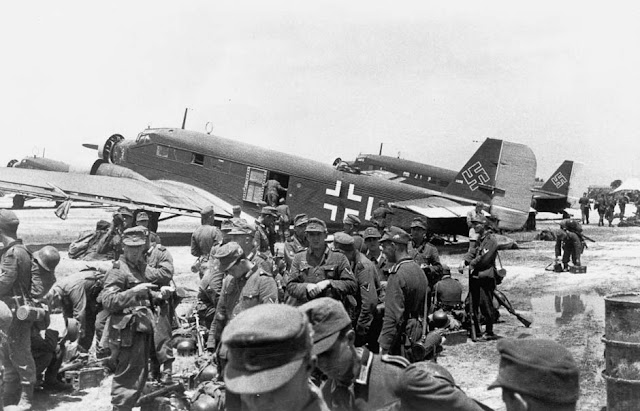 |
| 'German mountain troops board aircraft', URL: https://nzhistory.govt.nz/media/photo/german-mountain-troops-aircraft, (Ministry for Culture and Heritage), updated 15-Jul-2013. |
Future History: Giuseppe Giacomo Gambino is born in Palermo, Sicily. He grows up to become a member of the Mafia and head of the San Lorenzo mandamento. Gambino is part of a reputed "death squad" of the Corleonesi. Several high profile deaths are tied to Gambino, including anti-mafia magistrates Giovanni Falcone and Paolo Borsellino, as well as the politician Salvo Lima in 1992, and businessman Libero Grassi, who opposed extortion by the Mafia. After arrest, Gambino commits suicide in San Vittore prison in Milan on 30 November 1996.
Robert Joseph Cox is born in Tulsa, Oklahoma. He becomes a talented baseball player and spends two years playing third base for the New York Yankees in 1968-69. After that, Bobby Cox becomes a noted Major League Baseball manager, compiling a record of 2504-2001, a .556 winning percentage, between 1978-2010 for the Atlanta Braves and Toronto Blue Jays.
May 1941
May 1, 1941: British Hold Tobruk
May 2, 1941: Anglo-Iraq War
May 3, 1941: Liverpool Hammered
May 4, 1941: Hitler Victory Speech
May 5, 1941: Patriots Day
May 6, 1941: Stalin In Command
May 7, 1941: May Blitz
May 8, 1941: Pinguin Sunk
May 9, 1941: U-110 Captured
May 10, 1941: Hess Flies Into History
May 11, 1941: The Hess Peace Plan
May 12, 1941: Tiger Arrives Safely
May 13, 1941: Keitel's Illegal Order
May 14, 1941: Holocaust in Paris
May 15, 1941: Operation Brevity
May 16, 1941: Blitz Ends
May 17, 1941: Habbaniya Relieved
May 18, 1941: Croatia Partitioned
May 19, 1941: Bismarck at Sea
May 20, 1941: Invasion of Crete
May 21, 1941: Robin Moore Sinking
May 22, 1941: Royal Navy Destruction Off Crete
May 23, 1941: Crete Must Be Won
May 24, 1941: Bismarck Sinks Hood
May 25, 1941: Lütjens' Brilliant Maneuver
May 26, 1941: Bismarck Stopped
May 27, 1941: Bismarck Sunk
May 28, 1941: Crete Lost
May 29, 1941: Royal Navy Mauled Off Crete
May 30, 1941: Sorge Warns, Stalin Ignores
May 31, 1941: British Take Baghdad
2020
